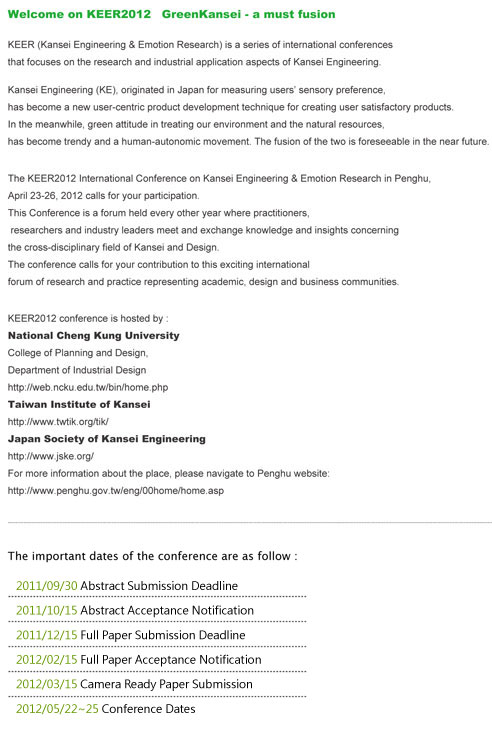Beyond Codes and Pixels
The 17th International Conference of the Association for Computer-Aided Architectural Design Research in Asia (CAADRIA)
Dates: April 25-28, 2012
Host: School of Architecture, Hindustan University, Chennai, India
Submission guidelines and other information:
http://caadria2012.orgFrom “brick and mortar” to “nuts and bolts”, and on to “codes and pixels”, the scope of architectural design technology, research and education is characterised by continuous expansion. On this journey of enrichment, digitally enabled thinkers help to rethink and to recast the building blocks, perceptive lenses, expressive features and analytical frames of architectural design in particular and of how humans perceive and make choices in general. Acknowledging that the possibilities of current digital processes and tools are far from exhausted, this conference seeks new thoughts, fresh approaches and a surge forward: What comes next?
Digital tools for seeing the new and for choosing what is best are deployed no longer just in the design studio and on the construction site. They mediate performances and experiences of the spaces and constraints of not only the creatively expressible and of the physically inhabitable, but increasingly also of the socially desirable. The organizers of this conference set out to investigate the future role of computer-aided architectural design (CAAD) research in this context.
CAADRIA 2012 invites submissions of original research papers, posters and exhibitions on topics in computational architectural design research, including but not limited to the following areas and aspects:
● Design intelligence and automation
● Design cognition and analysis
● Digital fabrication and construction
● Generative, parametric, and evolutionary design
● Digital documentation and design documentation
● Simulation and visualisation
● Animation and virtualisation
● Human-computer interaction
● Collaborative design
● Education in CAAD
● Ubiquitous and mobile design computing
● Practice-based and interdisciplinary CAAD
● Theory, philosophy, and methodology of CAAD
Young researchers currently involved in postgraduate studies are invited to apply for the Young CAADRIA Award and to submit their research-in-progress to the CAADRIA 2012 Postgraduate Student Consortium.
Important Dates
● Abstract submission: September 5, 2011
● Abstract acceptance notification: September 26, 2011
● Full paper submission: December 5, 2011
● Full paper acceptance notification: January 16, 2012
● Poster and exhibition submission: February 1, 2012
● Round Table submission: February 1, 2012
● Postgraduate Student Consortium submission: February 1, 2012
● Young CAADRIA Award submission: February 1, 2012
● Sasada Award nomination deadline: November 30, 2011 (a separate call for nominations will be issued in due course)
CAADRIA 2012 Host Organising Committee
Prof. Lt. Col. (Retd) A. B. Das, Dean, School of Architecture, Hindustan University (chair)
Mrs. Sheeba Chander, School of Architecture, Hindustan University (convener)
Mrs. Devyani Gangopadhyay, School of Architecture, Hindustan University (co-convener)
Ar. R. Balaji, School of Architecture, Hindustan University (executive co-ordinator)
Contact:
caadria@hindustanuniv.ac.inCAADRIA 2012 Paper Selection Committee
Thomas Fischer, Xi'an Jiaotong-Liverpool University, China (chair)
Kaustuv De Biswas, School of Architecture, Hindustan University
Jeremy J. Ham, Deakin University, Australia
Weixin Huang, Tsinghua University, China
Ryusuke Naka, Kyoto Institute of Technology, Japan
Contact:
psc@caadria-review.org